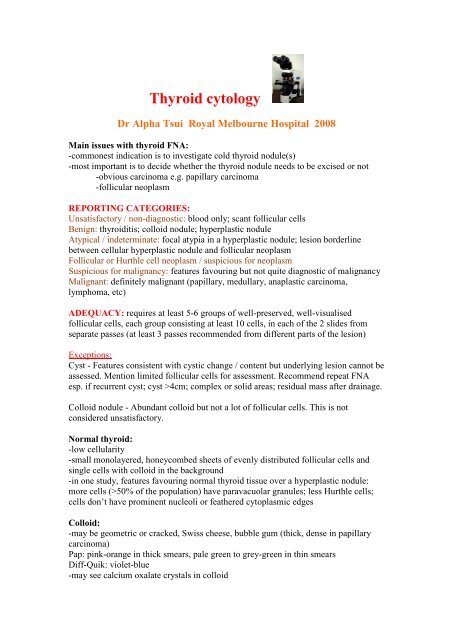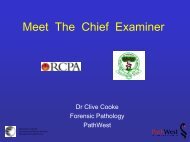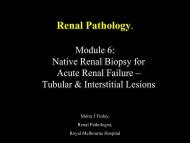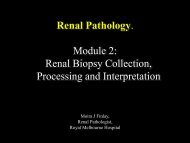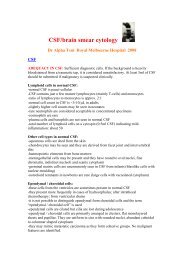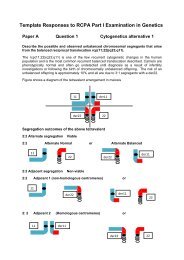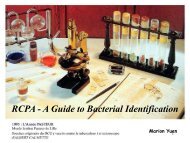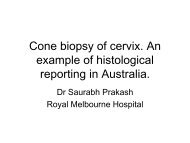Thyroid cytology - RCPA
Thyroid cytology - RCPA
Thyroid cytology - RCPA
Create successful ePaper yourself
Turn your PDF publications into a flip-book with our unique Google optimized e-Paper software.
<strong>Thyroid</strong> <strong>cytology</strong><br />
Dr Alpha Tsui Royal Melbourne Hospital 2008<br />
Main issues with thyroid FNA:<br />
-commonest indication is to investigate cold thyroid nodule(s)<br />
-most important is to decide whether the thyroid nodule needs to be excised or not<br />
-obvious carcinoma e.g. papillary carcinoma<br />
-follicular neoplasm<br />
REPORTING CATEGORIES:<br />
Unsatisfactory / non-diagnostic: blood only; scant follicular cells<br />
Benign: thyroiditis; colloid nodule; hyperplastic nodule<br />
Atypical / indeterminate: focal atypia in a hyperplastic nodule; lesion borderline<br />
between cellular hyperplastic nodule and follicular neoplasm<br />
Follicular or Hurthle cell neoplasm / suspicious for neoplasm<br />
Suspicious for malignancy: features favouring but not quite diagnostic of malignancy<br />
Malignant: definitely malignant (papillary, medullary, anaplastic carcinoma,<br />
lymphoma, etc)<br />
ADEQUACY: requires at least 5-6 groups of well-preserved, well-visualised<br />
follicular cells, each group consisting at least 10 cells, in each of the 2 slides from<br />
separate passes (at least 3 passes recommended from different parts of the lesion)<br />
Exceptions:<br />
Cyst - Features consistent with cystic change / content but underlying lesion cannot be<br />
assessed. Mention limited follicular cells for assessment. Recommend repeat FNA<br />
esp. if recurrent cyst; cyst >4cm; complex or solid areas; residual mass after drainage.<br />
Colloid nodule - Abundant colloid but not a lot of follicular cells. This is not<br />
considered unsatisfactory.<br />
Normal thyroid:<br />
-low cellularity<br />
-small monolayered, honeycombed sheets of evenly distributed follicular cells and<br />
single cells with colloid in the background<br />
-in one study, features favouring normal thyroid tissue over a hyperplastic nodule:<br />
more cells (>50% of the population) have paravacuolar granules; less Hurthle cells;<br />
cells don’t have prominent nucleoli or feathered cytoplasmic edges<br />
Colloid:<br />
-may be geometric or cracked, Swiss cheese, bubble gum (thick, dense in papillary<br />
carcinoma)<br />
Pap: pink-orange in thick smears, pale green to grey-green in thin smears<br />
Diff-Quik: violet-blue<br />
-may see calcium oxalate crystals in colloid
Colloid tends to surround follicular cells. Serum accumulates at the edges<br />
of the slide during smearing and around clumps of platelets and erythrocytes.<br />
Paravacuolar granules:<br />
-1 or more vacuoles lying close to the nucleus of a follicular cell. Within the vacuoles<br />
are small granules.<br />
-these represent lysosomes containing haemosiderin or lipofuscin: blue (Diff-Quik) or<br />
green (Pap)<br />
Amyloid:<br />
-amorphous or dense homogeneous appearance<br />
-may be surrounded by multinucleated giant cells<br />
-stains similarly to colloid<br />
Flame cells or fire-flare:<br />
-vacuoles of secretory material extruded from follicular cells, reflecting hyperactivity<br />
-stains pink on Diff-Quik, pale green on Pap<br />
-may be seen in Graves’ disease, Hashimoto’s thyroiditis, hyperplastic nodule,<br />
follicular neoplasm and follicular variant of papillary carcinoma<br />
-presence of flame cells in a metastasis may suggest thyroid in origin<br />
Microfollicles seen in:<br />
1. Hyperplastic nodule<br />
2. Chronic lymphocytic thyroiditis<br />
3. Follicular neoplasm<br />
4. Hurthle cell neoplasm<br />
5. Follicular variant of papillary carcinoma<br />
6. Parathyroid adenoma<br />
Papillary pattern seen in:<br />
1. Graves’ disease<br />
2. Hyperplastic nodule (with papillary hyperplasia)<br />
3. <strong>Thyroid</strong>itis<br />
4. Papillary Hurthle cell neoplasm<br />
5. Papillary carcinoma<br />
6. Medullary carcinoma (papillary variant)<br />
Nuclear grooves seen in:<br />
1. Papillary carcinoma<br />
2. <strong>Thyroid</strong>itis<br />
3. Nodular hyperplasia<br />
4. Follicular neoplasm<br />
5. Insular carcinoma<br />
Intranuclear pseudoinclusions seen in:<br />
1. Nodular hyperplasia<br />
2. Hashimoto’s thyroiditis<br />
3. Papillary carcinoma
4. Follicular neoplasm<br />
5. Hurthle cell neoplasm<br />
6. Medullary carcinoma<br />
7. Anaplastic carcinoma<br />
8. Insular carcinoma<br />
9. Hyalinising trabecular adenoma<br />
10. Metastases e.g. melanoma<br />
Pale nuclei with powdery chromatin seen in:<br />
1. Papillary carcinoma<br />
2. Hyperplastic nodule<br />
Bubble-gum colloid seen in:<br />
1. Papillary carcinoma<br />
2. Graves’ disease<br />
Psammoma bodies seen in:<br />
1. Nodular hyperplasia<br />
2. Hashimoto’s thyroiditis<br />
3. Graves’ disease<br />
4. Papillary carcinoma<br />
5. Medullary carcinoma<br />
6. Mucoepidermoid carcinoma<br />
Differential diagnosis of Hurthle cell lesions:<br />
1. Hyperplastic nodule<br />
2. Hurthle cells in Hashimoto's thyroiditis<br />
3. Hurthle cell neoplasm<br />
4. Oxyphilic or Warthin-like variant of papillary carcinoma<br />
5. Parathyroid hyperplasia and adenoma<br />
Differential diagnosis of clear cell lesions:<br />
1. Graves’disease<br />
2. Hashimoto’s thyroiditis<br />
3. Multinodular goiter<br />
4. Follicular neoplasm<br />
5. Papillary carcinoma<br />
6. Medullary carcinoma<br />
7. Parathyroid lesions<br />
8. Metastatic renal cell carcinoma<br />
Differential diagnosis of lesions with signet-ring cells:<br />
1. Multinodular goiter<br />
2. Follicular neoplasm<br />
3. Papillary carcinoma<br />
4. Metastatic carcinoma from the breast or stomach<br />
Multi-nucleated giant cells:<br />
1. De Quervain’s thyroiditis<br />
2. Other granulomatous thyroiditis e.g. TB, sarcoidosis
3. Multinodular goitre<br />
4. Hashimoto’s thyroiditis<br />
5. Papillary carcinoma<br />
6. Anaplastic carcinoma<br />
Lymphocyte-rich smears:<br />
1. <strong>Thyroid</strong>itis<br />
2. Multinodular goiter (usually associated with lymphocytic thyroiditis)<br />
3. Around tumours: papillary, anaplastic carcinoma<br />
4. Lymphoma<br />
Specific entities:<br />
<strong>Thyroid</strong> cyst:<br />
-may be due to degeneration, accumulation of colloid, haemorrhage<br />
-an entirely cystic nodule does not necessarily mean that it is benign<br />
-contains colloid, serum, blood, foamy macrophages with no or few degenerate<br />
epithelial cells (these findings are non-diagnostic as to the true nature of the cyst)<br />
-should always comment on paucity of follicular cells<br />
-always follow-up the patient, even if the cyst is completely collapsed after FNA<br />
10-15% of thyroid cysts are malignant. Look carefully<br />
for nuclear features of papillary carcinoma.<br />
Cyst lining cells:<br />
-these cells line dilated cystic follicles and they show reactive / repair-like changes,<br />
mimicking papillary carcinoma<br />
-they form 2D flat monolayered sheets with no nuclear crowding and presence of<br />
“windows” in-between the cells<br />
-no papillae present<br />
-the cells have enlarged round to ovoid nuclei, intranuclear grooves (can be quite a<br />
lot), fine chromatin and a distinct nucleolus<br />
-no intranuclear pseudoinclusions<br />
-the cytoplasm is typically spindled and granular<br />
-epithelioid cells may also be seen, resembling Hurthle cells<br />
-nuclear crowding, intranuclear pseudoinclusions, absence of cytoplasmic spindling,<br />
papillary structures and psammoma bodies favour a cystic papillary carcinoma<br />
-CK19 and HBME1 may be helpful. Both negative in benign lesions. Both strongly<br />
positive indicating papillary carcinoma.<br />
Colloid nodule:<br />
-aspirate contains abundant colloid, scant follicular cells<br />
-follicular cells may be dispersed or grouped into follicles and small monolayer sheets<br />
-the cells are small, uniform with central nucleus; cytoplasm pale and containing<br />
abundant paravacuolar granules; inconspicuous nucleoli<br />
-may have Hurthle cells, isolated or in monolayers<br />
Acute thyroiditis:
-numerous neutrophils, degenerate debris<br />
-occasional reactive follicular cells with prominent nucleoli<br />
-may see organisms in the background<br />
Graves’ disease:<br />
-cellular smear with similar features to hyperplastic nodule<br />
-small and large groups of follicular cells with thin colloid<br />
-characteristic flame cells are seen (cytoplasmic vacuoles with red to pink granular<br />
material, corresponding to phagolysosomes)<br />
-considerable nuclear atypia may occur: nuclear enlargement, overlapping, enlarged<br />
nucleoli<br />
-pseudopapillary groups can be seen<br />
-psammoma bodies have been reported<br />
-diagnosis needs to be correlated with clinical history and biochemistry<br />
Granulomatous (subacute, de Quervain’s) thyroiditis:<br />
-in early stage: neutrophils, reactive follicular cells, scarce granulomas<br />
-later stage: granulomas, giant cells, chronic inflammation, few neutrophils, fibrous<br />
fragments<br />
-giant cells often contain phagocytosed colloid<br />
-usually scant follicular epithelium<br />
-“dirty” background with inflammatory cells, colloid (not abundant) and debris<br />
The FNA procedure is often very painful which is a clue to the diagnosis.<br />
Riedel’s thyroiditis:<br />
-almost always paucicellular<br />
-mainly shows fibrous tissue fragments and chronic inflammatory cells<br />
-only few follicular cells present<br />
-granulomas are absent<br />
Hashimoto’s thyroiditis:<br />
-heterogeneous lymphoid population with Hurthle cells. Both must exist to make this<br />
diagnosis<br />
-abundant follicular centre fragments, tingible body macrophages and<br />
lymphoglandular bodies<br />
-lymphocytes embedded within the groups of follicular / Hurthle cells a characteristic<br />
feature<br />
-Hurthle cells may show increased N/C ratio, prominent nucleoli and nuclear<br />
irregularity; some spindling also present<br />
-colloid is scant<br />
-squamous metaplastic cells, foam cells, giant cells, fibrous tissue, granulomas and<br />
psammoma bodies may be present<br />
-beware co-existing Hurthle cell neoplasm (separate monotonous population of<br />
Hurthle cells devoid of lymphocytes), papillary carcinoma or lymphoma<br />
A complete absence of follicular or Hurthle cells should raise possibility<br />
of an intrathyroidal lymph node.
Dyshormonogenetic goiter:<br />
-diagnosis requires clinical correlation<br />
-hyperplastic changes with papillary structures<br />
-may have extreme cytological atypia<br />
Hyperplastic nodule:<br />
-variable amount of colloid<br />
-numerous follicular cells arranged mainly in monolayers, follicles and tissue<br />
fragments<br />
-large monolayered honeycombed sheets (representing macrofollicles) with evenly<br />
distributed nuclei without overlapping is an indicator of benignity<br />
-true papillae with fibrovascular cores can be seen. Pseudopapillary structures are not<br />
uncommon (usually short and nonbranching). There should not be significant<br />
overlapping or crowding of nuclei.<br />
-occasional microfollicles are present. Increased numbers of microfollicles may be<br />
seen in a cellular hyperplastic nodule. Predominance of microfollicles is suspicious<br />
for follicular neoplasm. Difficult to distinguish cellular hyperplastic nodule from<br />
follicular neoplasm in some cases.<br />
-follicular cells are slightly enlarged and may be found isolated in the background<br />
-the cytoplasm is abundant, delicate or dense<br />
-may have Hurthle cells<br />
Main features of hyperplastic nodule: normal follicular cells and<br />
Hurthle cells; lack of microfollicles; monolayered honeycombed sheets<br />
with no nuclear overlapping; degenerative changes<br />
Occasional nuclear grooves may be found in most hyperplastic<br />
nodules. If many cells have grooves, beware papillary carcinoma.<br />
Follicular neoplasm:<br />
-markedly hypercellular with little or no colloid<br />
-usually microfollicular or solid pattern<br />
-microfollicles: a ring of 5-15 cells with well-defined lumen, sometimes surrounding a<br />
ball of colloid<br />
-rosettes: rings of cells without a true central lumen<br />
-follicular cells can be arranged in tissue fragments, 3-D clusters with syncytial<br />
pattern, trabeculae and in microfollicles / rosettes<br />
-microfollicular pattern >50% of aspirate or distinct (low-power) on 1-2 slides<br />
-monolayers in honeycomb pattern are rare or absent<br />
-follicular cells tend to be crowded and disorganised. They are monomorphic, the<br />
cytoplasm pale with no paravacuolar granules or oxyphilic changes. The nucleus is<br />
round and has a smooth contour. Nuclear chromatin appears finely to coarsely<br />
granular and uniformly dispersed. The nucleolus is small and uniform.<br />
-features suggestive of carcinoma: moderate to high cellularity within cell groups,<br />
poorly formed follicular structures, disarray and crowding of cells in the cell groups,<br />
numerous isolated cells, moderate to large nuclear size, chromatin irregularly<br />
distributed, prominent or multiple nucleoli, necrotic debris
The diagnosis of follicular carcinoma is not made on <strong>cytology</strong>. The<br />
diagnosis is made histologically in the presence of transcapsular and/or vascular<br />
invasion. The term “follicular neoplasm” is used in <strong>cytology</strong> to include adenoma /<br />
carcinoma.<br />
Hurthle cell neoplasm:<br />
-same as follicular neoplasm except the majority of the cells are Hurthle cells<br />
-forms clusters, microfollicles and single cells with scant colloid<br />
-rare cases may show papillae<br />
-some cells may have intranuclear grooves and pseudoinclusions<br />
-cells with prominent nucleoli favour Hurthle cells, as compared to small nucleoli in<br />
cells from papillary carcinoma with squamoid cytoplasm<br />
Papillary carcinoma:<br />
-cellular<br />
-little or no colloid in the background (colloid may appear as dense, globular, bubble<br />
gum-like – uncommon feature)<br />
-cells arranged in papillary, monolayer tissue fragments, clusters or dispersed as<br />
single cells<br />
-well-formed papillary clusters that appear as 3-D finger-like (smears do not always<br />
contain papillae)<br />
-most frequently seen architectural feature: sheets of cohesive cells, focally with<br />
nuclear crowding and overlapping and in parts with a distinct well defined<br />
“anatomical” edge of a row of cuboidal or columnar cells (due to flattening of papillae<br />
when the sample is smeared)<br />
-cells have a polygonal contour with well-defined margins and a central nucleus<br />
-cytoplasm generally abundant, sometimes dense and homogeneous or granular with<br />
well-defined cytoplasmic borders (may look squamoid or metaplastic)<br />
-cells may contain numerous vacuoles or show clear-cell change<br />
-nuclei are oval or angled (arrow-head shape) and moderately enlarged<br />
-chromatin is finely granular, delicate, 'powdery', hypochromatic and the nucleolus is<br />
small<br />
-optically clear “Orphan Annie” nuclei are not seen (fixation artifact) on routine Pap<br />
stain<br />
-however, nuclear clearing has been described in Ultrafast Papanicolaou-stained<br />
smears<br />
-nuclear pseudoinclusions and longitudinal folds are often noted (the more cells that<br />
are involved, the more specific is the diagnosis)<br />
-nuclear pseudoinclusions are more specific than grooves for papillary carcinoma<br />
-more than 20% of the cells with grooves are virually diagnostic for papillary<br />
carcinoma. Less than 10% of the cells with nuclear grooves virtually excludes a<br />
diagnosis of papillary carcinoma.<br />
-multinucleated giant cells are found up to 50% of cases (some believe this is<br />
relatively specific; giant cells may be seen in Hashimoto’s thyroiditis and nodular<br />
hyperplasia)<br />
-psammoma bodies (only with typical concentric lamination counts) are seen
Key diagnostic criteria: pseudoinclusions, grooves, papillary structures and<br />
metaplastic cytoplasm. If all are present, a diagnosis of papillary carcinoma is almost<br />
guaranteed. Diagnostic nuclear features often involve most of the cells in a wellsampled<br />
papillary carcinoma. Just a few grooves, for example, are not sufficient for a<br />
diagnosis of malignancy.<br />
Follicular variant:<br />
-syncytial fragments, monolayered branched sheets with irregular contours,<br />
microfollicular structures<br />
-lack papillae<br />
-presence of typical nuclear features including nuclear grooves, powdery<br />
hypochromatic chromatin and intranuclear pseudoinclusions<br />
-thick colloid in the background<br />
Always look at the microfollicles carefully for nuclear features of papillary<br />
carcinoma.<br />
Oncocytic / oxyphilic variant:<br />
-usually a follicular growth pattern<br />
-typical nuclear features are seen, along with abundant granular cytoplasm<br />
Solid / trabecular variant:<br />
-syncytial tissue fragments and trabeculae, without papillae or follicles<br />
Macrofollicular variant:<br />
-features easily confused with those of a hyperplastic nodule; need to look carefully<br />
for the typical nuclear features<br />
-tissue fragments and follicles<br />
-abundant colloid in the background<br />
Diffuse sclerosing variant:<br />
-dense lymphoplasmacytic inflammation<br />
-monolayer sheets of squamous metaplastic cells<br />
-numerous psammoma bodies<br />
-abundant fibrous tissue in the background<br />
Tall-cell variant:<br />
-columnar cells with poorly to well demarcated cytoplasm and high N/C ratio<br />
-cells are twice as tall as they are wide<br />
Columnar-cell variant:<br />
-papillary fragments covered by characteristic pseudostratified columnar cells with<br />
picket-fence nuclei<br />
-cells with clear cylindrical cytoplasm and polarised oval nucleus<br />
-nuclei containing stippled chromatin and indistinct nucleoli<br />
-nuclear grooves are uncommon<br />
-nuclear pseudoinclusions are absent
Hyalinising trabecular tumour (adenoma / carcinoma):<br />
-some believe this to be a variant of papillary carcinoma<br />
-may show psammoma bodies, fine chromatin, nuclear grooves and pseudoinclusions<br />
-papillary structures and bubble-gum colloid are absent<br />
-cells characteristically separated by metachromatic stromal substance<br />
-cells may be single and/or in follicles<br />
-spindle cells are present<br />
Medullary carcinoma:<br />
-cellular smear with loosely cohesive syncytial cell clusters, rosettes or isolated cells<br />
-may be as a population of single or admixture of cell-types<br />
-cell types include plasmacytoid, spindle, polygonal, round or triangular<br />
-nuclei with coarsely granular or speckled chromatin and inconspicuous nucleoli<br />
(neuroendocrine morphology)<br />
-bi and multinucleation are seen frequently<br />
-intranuclear pseudoinclusions are also present<br />
-cytoplasm is finely granular and may contain red granules (seen in 30% of cases with<br />
Diff-Quik) – important feature<br />
-amyloid is present in the background (often with rounded edges, finely fibrillary,<br />
Congo-red positive, apple-green birefringence under polarised light)<br />
Insular carcinoma:<br />
-a cross between papillary carcinoma and follicular carcinoma<br />
-there are solid syncytial aggregates, trabeculae, microfollicles and single cells with<br />
no colloid<br />
-the cells appear monotonous with irregular nuclei, nuclear grooves,<br />
pseudoinclusions, nuclear overlapping, crowding and cytoplasmic vacuoles<br />
-papillae are not a feature<br />
-metaplastic cytoplasm is not seen<br />
-necrosis is frequent<br />
Anaplastic carcinoma:<br />
-tumour cells are mostly dispersed but monolayers and three-dimensional clusters can<br />
be uncommonly found<br />
-background is usually rich in necrotic debris and blood<br />
-an inflammatory component rich in neutrophils may be present<br />
-a mixture of giant cells and spindle cells<br />
-tumour cells vary in the size and shape and may be pleomorphic, round or spindled<br />
-cells are mostly mononucleated though bi or multi-nucleation may be seen<br />
-nuclei are round, oval, irregular or bizarre with hyperchromasia and coarse, uneven<br />
chromatin structure<br />
-nucleoli can range from small to large, often single and irregular<br />
-cytoplasm is moderate to abundant, basophilic and well-defined which sometimes<br />
may be vacuolated or granular<br />
-some cells may have a plasmacytoid appearance while others may have a squamoid<br />
appearance<br />
-intranuclear inclusions are relatively frequent<br />
-osteoclast-like giant cells can sometimes be seen<br />
-differentiated structures such as papillae or follicles may be present in some cases
Lymphoma:<br />
-cellular smears of monotonous population of atypical lymphoid cells<br />
-small to large cells depending on the subtype<br />
-lymphoglandular bodies in the background<br />
-large numbers of Hurthle cells or follicular cells are not seen<br />
Radioactive iodine effect:<br />
-clinical correlation is mandatory<br />
-increased cellularity<br />
-cellular enlargement but low N/C ratio, hyperchromasia, intranuclear grooves,<br />
pseudoincludions, metaplastic oxyphilic cytoplasm with vacuolisation<br />
-papillary groups, high N/C ratio, powdery chromatin absent<br />
FALSE POSITIVES:<br />
-atypical adenoma with bizarre cells<br />
-dyshormonogenetic goitre with anisokaryosis and nuclear atypia<br />
-treated Graves' disease<br />
-post chemoradiotherapy or radioactive iodine treatment<br />
-atypical oxyphilic cells in Hashimoto's thyroiditis<br />
-pseudopapillary structures in non-neoplastic thyroid lesions<br />
-intranuclear vacuoles, nuclear grooves, psammoma bodies in benign lesions<br />
FALSE NEGATIVES:<br />
-cystic papillary carcinoma<br />
-follicular variant of papillary carcinoma<br />
-follicular carcinoma with bland cells<br />
-paucicellular variant of anaplastic carcinoma, tumour with extensive necrosis or<br />
inflammation<br />
-lymphoma arising from a background of Hashimoto's thyroiditis<br />
PRACTICAL TIPS:<br />
1. Know your radiologist, the clinical history, solitary or multinodular lesion, gauge<br />
of needle used, with or without suction.<br />
2. Markedly cellular material with large "sheared out" sheets is probably due to<br />
aggressive sampling. They are usually monolayered honeycombed sheets. It does<br />
not indicate a follicular neoplasm.<br />
3. Occasional markedly pleomorphic cells in a follicular lesion are more likely to be<br />
from a benign lesion than malignancy. It may represent a degenerative
phenomenon. Can be seen in treated Graves’, dyshormonogenetic goiter, posttherapy.<br />
4. Uniform nuclear enlargement and atypia without much variation in size and shape<br />
is more suggestive of malignancy in follicular lesions.<br />
5. Hurthle cell atypia may be more pronounced in Hashimoto’s thyroiditis than from<br />
a Hurthle cell neoplasm.<br />
6. Look very carefully for features of papillary carcinoma in any cystic lesion.<br />
Features that a cyst may be a papillary carcinoma: increased cellularity, epithelial<br />
atypia and psammoma bodies.<br />
7. Abundant colloid may be present in cystic and macrofollicular variants of<br />
papillary carcinoma. The amount of colloid present is not a reliable indicator<br />
whether the lesion is benign or malignant.<br />
8. Presence of papillary structures does not always mean papillary carcinoma. Look<br />
for the typical nuclear features.<br />
9. Presence of psammoma bodies in acellular fluid from a cystic lesion or in smears<br />
from cervical lymph nodes strongly suggests papillary carcinoma and must be<br />
excluded clinically. Cystic degeneration in a cervical lymph node in a young<br />
patient should raise suspicion of metastatic papillary carcinoma and the thyroid<br />
should be carefully examined.<br />
10. Beware significant numbers of inflammatory cells in the background which may<br />
be easily overlooked. May well be dealing with a thyroiditis. In true thyroiditis,<br />
epithelial cells are usually scanty.<br />
11. Small numbers of microfollicles are seen in a hyperplastic nodule. Abundant<br />
microfollicles strongly suggest follicular neoplasm. Always look for other features<br />
that are more typical of a hyperplastic nodule. Hence, multiple sampling of<br />
different parts of the lesion is very important.<br />
12. If both abundant colloid and marked cellularity are present, the lesion is probably<br />
a cellular hyperplastic nodule or follicular neoplasm with macrofollicular areas. If<br />
both colloid and cellularity are low, repeat FNA is recommended.
Parathyroid adenoma vs thyroid lesion:<br />
Parathyroid<br />
Hyperparathyroidism +<br />
Cells Usually smaller<br />
Nuclei 'Salt and pepper' coarse chromatin<br />
Intranuclear vacuoles<br />
Many naked nuclei<br />
Cytoplasm Fine, red (neurosecretory granules)<br />
Cytoplasmic vacuoles<br />
Colloid Absent<br />
Background Usually clean; no foamy macrophages;<br />
no calcium oxalate crystals under<br />
polarized light<br />
Immunostains PTH+<br />
<strong>Thyroid</strong><br />
-<br />
Usually larger<br />
Fine chromatin<br />
Fewer naked nuclei<br />
Coarse, blue<br />
Present<br />
Often degenerated;<br />
calcium oxalate crystals<br />
identified<br />
Thyroglobulin, TTF-1+
Fig 1. Colloid with a definite edge.<br />
Fig 2. Colloid with a cracked appearance.
Fig 3. Thick and globular “Bubble-gum” colloid in a papillary carcinoma.<br />
Fig 4. Amyloid deposits.
Fig 5. Blood, serum and clumped platelets.<br />
Fig 6. Monolayered honeycombed sheet of uniform follicular cells (Implies sampling<br />
from a benign macrofollicle).
Fig 7. Hurthle cells with granular eosinophilic cytoplasm.<br />
Fig 8. Hurthle cells.
Fig 9. Graves’ disease. Note: Occasional cells with nuclear enlargement.<br />
Fig 10. Hashimoto’s thyroiditis. Hurthle cells and lymphocytes within the groups and<br />
in the background.
Fig 11. Hashimoto’s thyroiditis with spindled and epitheloid Hurthle cells.<br />
Fig 12. De Quervain’s thyroiditis. Multi-nucleated giant cells.
Fig 13. Hyperplastic nodule. Sheets of follicular cells with abundant colloid in the<br />
background. No microfollicular structures.<br />
Fig 14. Hyperplastic nodule. Follicular cells with colloid.
Fig 15. Aggressive sampling from a hyperplastic nodule with many monolayered<br />
sheets and no microfollicles.<br />
Fig 16. Papillary hyperplasia. Well-formed papillary groups but lacking nuclear<br />
features of papillary carcinoma. Follicular cells have round nuclei.
Fig 17. Occasional atypical cells in an otherwise typical hyperplastic nodule do not<br />
indicate malignancy (Arrow).<br />
Fig 18. Reactive follicular cells with prominent nucleoli and vacuolated cytoplasm<br />
(degenerative change).
Fig 19. Follicular neoplasm with marked cellularity.<br />
Fig 20. Follicular neoplasm with marked cellularity and microfollicles.
Fig 21. Follicular neoplasm with rosettes (no lumen).<br />
Fig 22. Follicular neoplasm with trabecular arrangement. This pattern is not seen in<br />
hyperplastic nodules.
Fig 23. Follicular neoplasm with trabecular arrangement.<br />
Fig 24. Hurthle cell neoplasm with marked cellularity.
Fig 25. Hurthle cell neoplasm with microfollicles (Arrow).<br />
Fig 26. Papillary carcinoma with complex papillae.
Fig 27. Papillary carcinoma. Papillary group with anatomical straight edge (Arrow).<br />
Fig 28. Papillary carcinoma. Note row of palisaded tumour cells (Arrow).
Fig 29. Papillary carcinoma. Note nuclear enlargement and intranuclear<br />
pseudoinclusion (Arrow).<br />
Fig 30. Papillary carcinoma. Nuclear grooves (Arrows).
Fig 31. Papillary carcinoma. Note fine powdery chromatin.<br />
Fig 32. Papillary carcinoma. Note squamoid “metaplastic” cells (Arrow).
Fig 33. Follicular variant of papillary carcinoma. Look carefully for the typical<br />
nuclear features.<br />
Fig 34. Cystic papillary carcinoma. Note cells with intranuclear pseudoinclusions.
Fig 35. Papillary carcinoma. Psammoma body present.<br />
Fig 36. Cyst-lining cells, mimicking papillary carcinoma. The spindled appearance is<br />
typical.
Fig 37. Cyst-lining cells with intranuclear grooves and elongated granular cytoplasm,<br />
the latter not seen in papillary carcinoma.<br />
Fig 38. Medullary carcinoma.
Fig 39. Medullary carcinoma. Tumour cells with finely granular chromatin and<br />
inconspicuous nucleoli.<br />
Fig 40. Medullary carcinoma. The cells are rather “bland” with round nuclei and<br />
granular cytoplasm. The cytoplasm is focally elongated.
Fig 41. Medullary carcinoma with a mixture of epithelioid and spindled cells.<br />
Fig 42. Anaplastic carcinoma with giant and spindled cells.
Fig 43. Parathyroid adenoma. Oncocytic cells and chief cells (stripped nuclei).<br />
Fig 44. Parathyroid adenoma. Oncocytic and chief cells are smaller than Hurthle and<br />
follicular cells of the thyroid. There is no colloid in the background.
Fig 45. Non-Hodgkin lymphoma of the thyroid.<br />
Fig 46. Metastatic adenocarcinoma from the lung to the thyroid.
References<br />
Orell SR, Philips J. Monographs in clinical <strong>cytology</strong> vol 14. The thyroid. Karger<br />
1997.<br />
Xin J et al. The clinical and diagnostic impact of using standard criteria of adequacy<br />
assessment and diagnostic terminology on thyroid nodule fine needle aspiration.<br />
Diagn Cytopathol 2008;36:161-166<br />
Baloch ZW et al. Diagnostic terminology and morphologic criteria for cytologic<br />
diagnosis of thyroid lesions: a synopsis of the National Cancer Institute thyroid fineneedle<br />
aspiration state of the science conference. Diagn Cytopathol 2008;36:425-437<br />
Nayar R et al. <strong>Thyroid</strong> aspiration <strong>cytology</strong>: A “cell pattern” approach to<br />
interpretation. Sem Diag Pathol 2001;18(2):81-98<br />
Faquin WC et al. “Atypical” cells in fine-needle aspiration biopsy specimens of<br />
benign thyroid cysts. Cancer Cytopathol 2005;105:71-79<br />
Yang YJ, Demirci SS. Evaluating the diagnostic significance of nuclear grooves in<br />
thyroid fine needle aspirates with a semiquantitative approach. Acta Cytol<br />
2003;47:563-570<br />
Khurana KK et al. Aspiration <strong>cytology</strong> of paediatric solitary papillary hyperplastic<br />
thyroid nodule. Potential pitfall. Arch Pathol Lab Med 2001;125:1575-1578<br />
Faser CR et al. Papillary tissue fragments as a diagnostic pitfall in fine-needle<br />
aspirations of thyroid nodules. Diagn Cytopathol 1997;16:454-459<br />
Centeno BA et al. Fine needle aspiration biopsy of the thyroid gland in patients with<br />
prior Graves’ disease treated with radioactive iodine. Morphologic findings and<br />
potential pitfalls. Acta Cytol 1996;40:1189-1197<br />
Tseleni-Balafouta S et al. Parathyroid proliferations. A source of diagnostic pitfalls in<br />
FNA of thyroid. Cancer Cytopathol 2007;111:130-136


